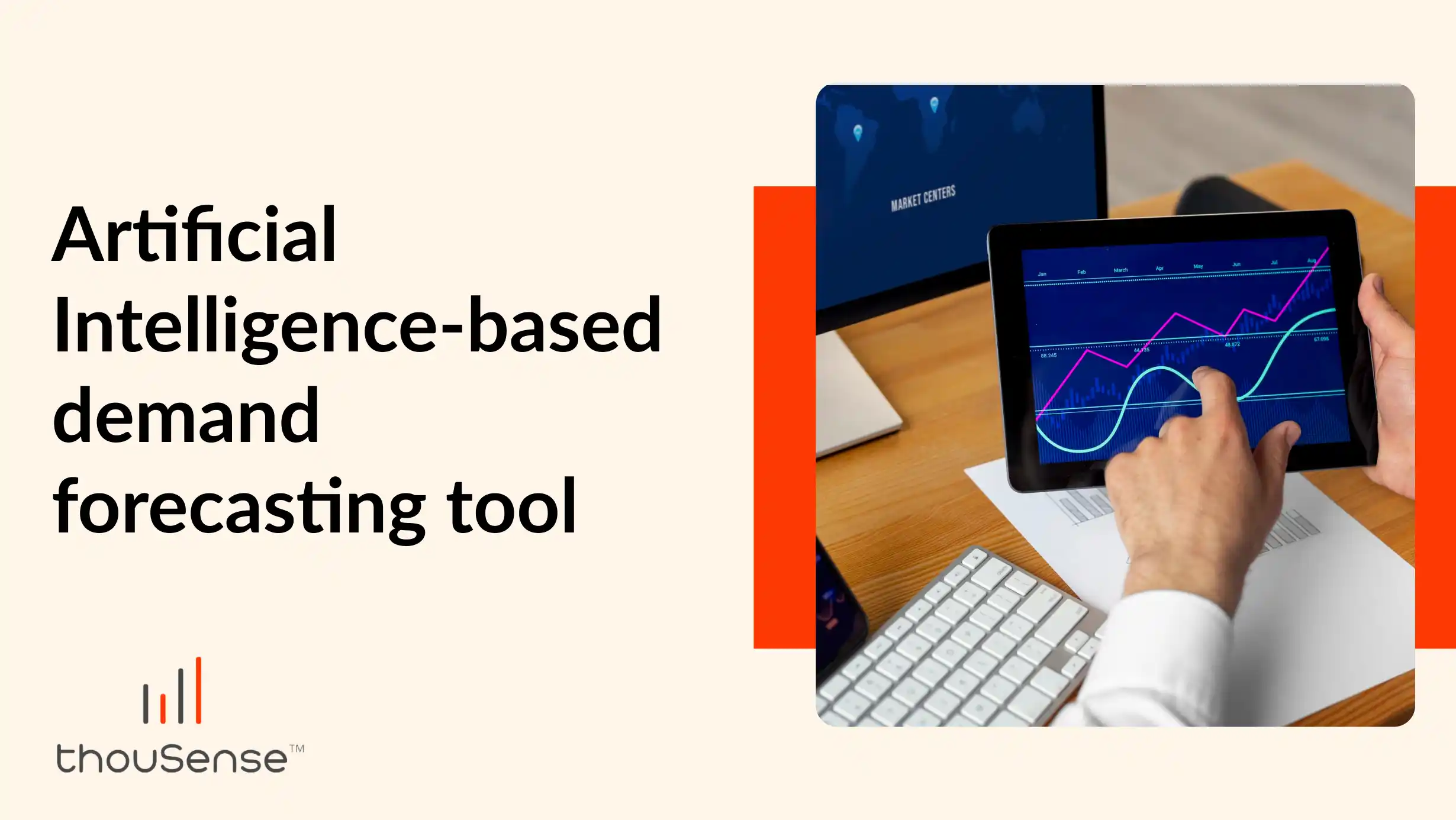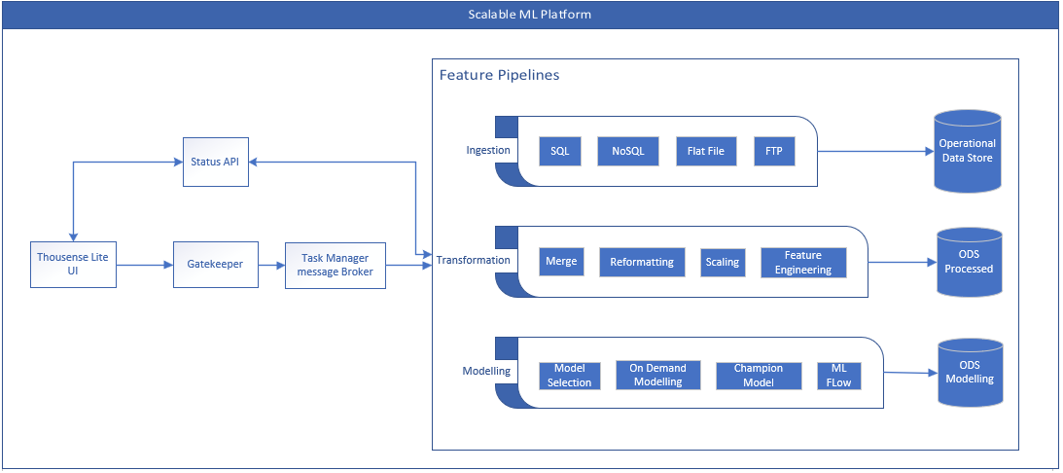Artificial Intelligence-based demand forecasting tool| thouSense

There are a lot of buzzwords hot in the Data Science industry right now. Why there is so much rave on the data science industry right now? Data Science is defined as the complete method for obtaining meaningful insights from unstructured data, which includes topics such as statistical analysis, data processing, machine learning techniques, modeling, data preparation, and so on.
However, demand forecasting has been a great challenge for many businesses due to its volatile and unpredictable factors. To create prediction models, Artificial Intelligence programmers employ complicated machine learning algorithms. One such amazing platform to forecast the demand for your business is thouSense Lite
The buzz words include Machine learning platform, scalability, microservice, message-based communication between services, async design, on-demand training, artificial intelligence algorithms, and a lot more. Along with this SaaS platform has conquered the technology market for a decade using powerful artificial intelligence and machine learning-based algorithms.
A SaaS platform is a software system for selling, distributing, and managing cloud-based services and applications. The SaaS model has pushed most of the technology market away from conventional software models. SaaS is an abbreviation for "Software-as-a-Service." This is due to the evolution of Artificial Intelligence algorithms in the software industry.
Organizations may utilize AI to forecast changes in customer demand as precisely as feasible by utilizing Machine Learning algorithms. This gives an accurate forecast when compared to traditional demand forecast techniques. Artificial Intelligence based algorithms can identify trends instantly, uncover complex correlations in vast datasets, and record indications for demand fluctuation. AI/ML-based forecasting systematically uses powerful algorithms to predict demand across businesses despite unknown factors. Check out our blog to know Why is Demand Forecasting the need of the hour?
In today’s blog, you will get an overview of how the thouSense platform utilizes all the mentioned buzzwords and AI/ML algorithms to build a SaaS platform for Demand forecasting. It is a lite version of the thouSense enterprise version. Do you still have a question on why to use AI/ML-based demand forecasting tools? Check out our blog on 5 Reasons Why You Should Use Machine Learning for Forecasting Demand
The system design of thousenseLite can work for any SaaS AI/ML platform. Now, let us walk you through the architecture flow. The basic flow of any Artificial Intelligence and Machine learning-based application is – data ingestion, enrichment, modeling, forecasting, and model serving. It is designed in such a way that it is scalable and provides ease of use.

Now let us walk you through the End-End flow of platform pipelines and operations.
Ingestion:
In simpler terms, it is the process of obtaining data from many sources and aggregating it in a processing environment. This procedure promotes integration while also providing independent applications such as data redundancy, log transmission, and so forth.
The Ingestion process in Thousense lite happens in the following way:
- UI will send out a configuration file and store it in DB. From DB the config file should be loaded in the execution engine for task verification, metadata verification, and connection Testing
- After successful tests, the execution engine will send the config file to compute engine, which will run the script to create Nifi Processors
- Config file will have the ability to run data pull now or schedule CRON for recurring data pulls
Data Enrichment:
Data enrichment is a technique for preparing data for study and use. This is done to improvise the raw data and access meaningful insights from them.
Data Modelling:
Once the insights are in place the data modeling which is a visual representation of the collected information is executed to know the overall flow of the system.
Execution Engine:
The executive engine is designed to adapt and deliver incoming requests efficiently.
- Task Queue – A simple FIFO (first-in-first-out) queue that is used for asynchronous execution of jobs in the background which are based on the operations provided by the user as input. This methodology is followed to avoid duplications and enhance line processing.
- Config Files – Stores the metadata about the operation to be performed. Ex: - source database, destination database, timestamp, the operation to be performed, scheduling, etc.
- Message Broker – A message broker is an intermediary that has the sole purpose of delivering the messages sent by the producer to the right consumer. Use case definition – Fetches the task from the task queue and distributes them to the worker nodes.
- Database – The place where config files and intermediate artifacts generated by different modules will be stored.
- Worker Nodes – One or a set of machines that receive data from message brokers and execute the given task in a distributed and parallel fashion.
- Status Check Service – Checks the status of the jobs and reports it to the user while it is being executed from the time of creation till completion.
Additional components required to make the above flow scalable:
- Entire workflows to be transformed into config files for each step
- Gatekeeper validates and verifies every component of the config file
- Task Manager, which takes the input of activity type from UI and then assigns it to the relevant pipeline
- Status API – to get the Live status of pipeline execution on UI
- Operational data store and data transformation – Data can be ingested in any format, SQL, No-SQL, Flat file, FTP, etc. It is not advisable to define workflows for each data type. We came up with a transformation service that converts all the data formats to SQL and stores the resultant dataset in the operational data store. It will be treated as a source of truth for all ML operations
All these services work in async architecture, in a micro-service deployment over Kubernetes. Asynchronous architecture is used since it is a non-blocking and event-based architecture. It is highly recommended because of its high performance, flexibility, and fast output. It can be used to scale any Artificial Intelligence and machine learning solution. Since demand forecasting requires high performance and fats output Artificial Intelligence algorithms are used. Other necessary support services include logging, auth server, infrastructure monitoring, and an alert engine. Check out more about us on https://thousense.ai/ and get your quote today!
Thus, Thousense Lite provides an excellent Artificial Intelligence-based demand forecasting tool to predict the demand for businesses. The major benefit of Thousense Lite is its scalability. It has an async architecture and scalable machine learning platform. Artificial Intelligence based demand forecasting provides an accurate as well as efficient output when compared to conventional methods. Learn more about The Power of AI/ML in demand forecasting to have a deeper understanding.
